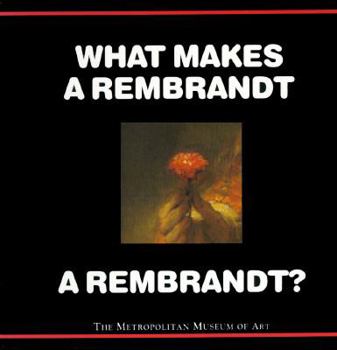What Makes a Rembrandt a Rembrandt?
(Part of the What Makes a... Series)
Select Format
Select Condition 
Book Overview
The work of Rembrandt is studied in this title of the bestselling What Makes a . . . series, now available in a handsome hardcover edition. The composition, line, color, subject matter, of 12 of... This description may be from another edition of this product.
Format:Hardcover
Language:English
ISBN:067085199X
ISBN13:9780670851997
Release Date:October 1993
Publisher:Viking Children's Books
Length:48 Pages
Weight:0.60 lbs.
Dimensions:0.3" x 9.0" x 8.5"
Age Range:9 to 12 years
Grade Range:Grades 4 to 7
Related Subjects
9 - 12 Years Art Children's Children's Books History Literature & Fiction Painting Teen & Young AdultCustomer Reviews
2 ratings
Wonderful Series
Published by Thriftbooks.com User , 14 years ago
Great series! They have more artistic information than we had expected. These books were like have our own tutor on each of the artist and their technique. We got more than we bargained for.
*Rembrandt deserves a Many-Tiered Birthday Cake for his 400 Candles*
Published by Thriftbooks.com User , 18 years ago
Rembrandt van Rijn, a favorite artist of the Dutch school, was very young when he began studying to be a painter. He was 'on his own' by age 23 after only six months with a successful painter-instructor. It wasn't long before he was sought-out and moved to Amsterdam, a more convenient location for the many portrait commissions he accepted. Rembrandt never traveled very far from Leiden where he was born in July 15, 1606. Try to imagine - - tulips were not introduced to Holland until his lifetime! The flower had a tumultuous history of its own (read "TULIPOMANIA" >> isbn # 060980765x << & similar titles) - - fortunately tulips were NOT banned as an invasive plant. There is one beautifully shown in the floral "crown" worn by "Flora" - a painting now hanging in the Hermitage, St. Petersburg, Russia. It demonstrates Rembrandt's delicate brush strokes and use of his palette. <br /> <br />Light and dark always played a primary "role" in van Rijn's works. The contrast, called by an Italian word >chiaroscuro< is often used when describing Rembrandt's painting style. The artist was famous for this use of light & dark to show contrast; he avoided symmetry, 'toyed with' perspective - -and the paintings included in this book serve to illustrate these important characteristics of his art. <br /> <br />Rembrandt often chose topics to paint that reflected his interest in married love, and in Biblical stories. In the latter, Dutch people were painted in familiar, not Palestinian, settings. The painting of the Mennonite preacher and his wife was new to me, and of particular interest. The author tells us that "the Bible dominates one half of the (entire)canvas." Anatomy lessons were another traditional subject for large canvases at that time. These were called "memento mori" - - Individuals in such group paintings often paid to be included. <br /> <br />New York's Metropolitan Museum of Art inaugurated this series of books for young readers and it was an inspired project. The author sheds true light on the art without condescending to readers. There is something encouraging about the author's tone as he instructs us about the many artist 'tricks' that were used & now aid our understanding & appreciation of the Rembrandt's mastery. Muhlberger also points out how changes in personality can be detected in self-portraits done at different stages of Rembrandt's life. These self-portraits involved the complicated positioning of two mirrors. <br /> <br />Thank you, Rembrandt van Rijn, for your works that have enriched lives through the centuries. And mcHaiku adds sincerest thanks to Richard Muhlberger, who compiled and edited this excellent & very readable book for young people (and fortunate others).





